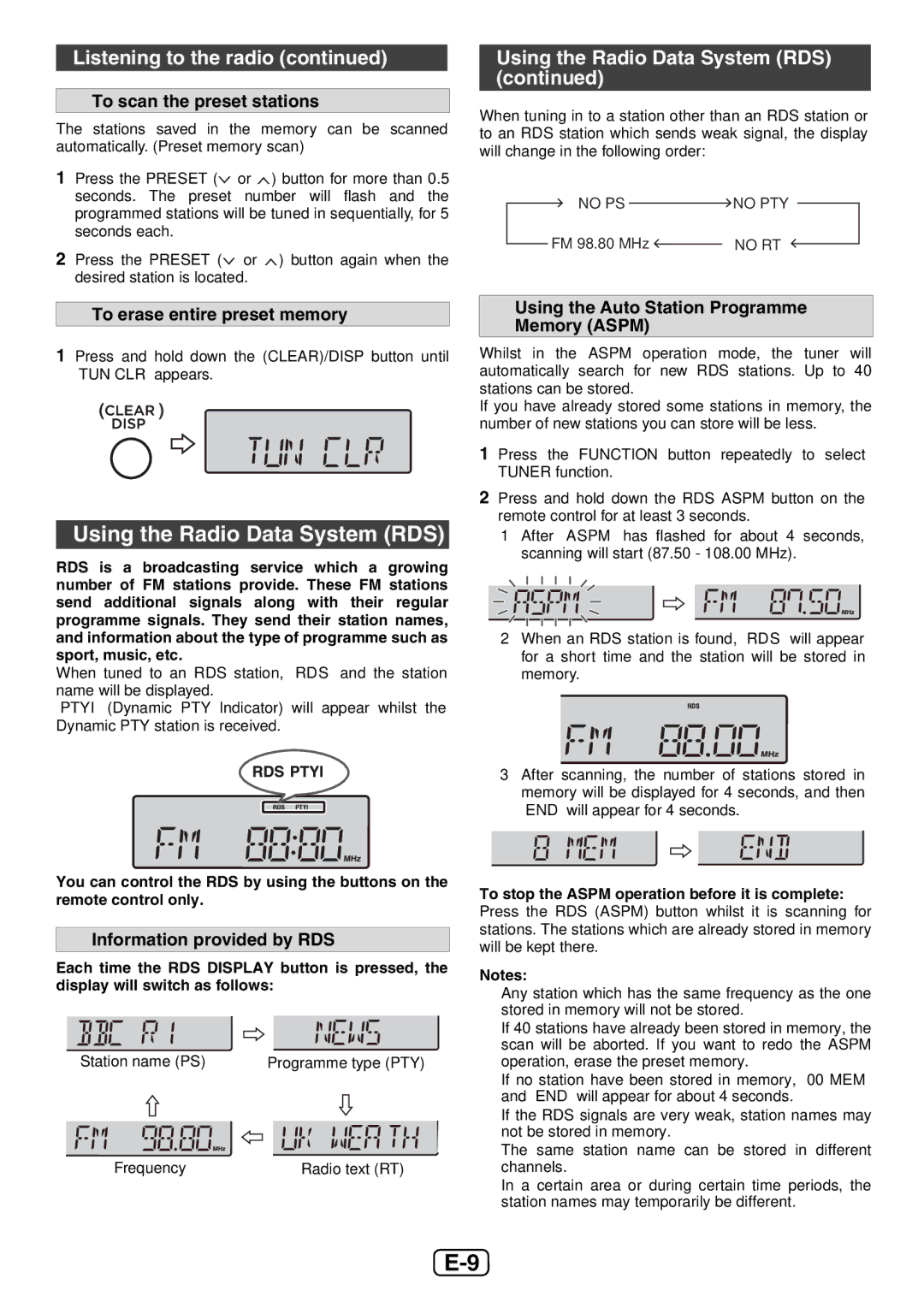
Listening to the radio (continued)
■To scan the preset stations
The stations saved in the memory can be scanned automatically. (Preset memory scan)
1Press the PRESET (![]() or
or ![]() ) button for more than 0.5 seconds. The preset number will flash and the programmed stations will be tuned in sequentially, for 5 seconds each.
) button for more than 0.5 seconds. The preset number will flash and the programmed stations will be tuned in sequentially, for 5 seconds each.
2Press the PRESET (![]() or
or ![]() ) button again when the desired station is located.
) button again when the desired station is located.
■To erase entire preset memory
1Press and hold down the (CLEAR)/DISP button until “TUN CLR” appears.
( ![]()
![]()
![]()
![]()
![]() )
)
Using the Radio Data System (RDS)
RDS is a broadcasting service which a growing number of FM stations provide. These FM stations send additional signals along with their regular programme signals. They send their station names, and information about the type of programme such as sport, music, etc.
When tuned to an RDS station, “RDS” and the station name will be displayed.
“PTYI” (Dynamic PTY Indicator) will appear whilst the Dynamic PTY station is received.
You can control the RDS by using the buttons on the remote control only.
■Information provided by RDS
Each time the RDS DISPLAY button is pressed, the display will switch as follows:
Station name (PS) | Programme type (PTY) |
Frequency | Radio text (RT) |
Using the Radio Data System (RDS) (continued)
When tuning in to a station other than an RDS station or to an RDS station which sends weak signal, the display will change in the following order:
NO PS | NO PTY |
FM 98.80 MHz ![]() NO RT
NO RT
■Using the Auto Station Programme Memory (ASPM)
Whilst in the ASPM operation mode, the tuner will automatically search for new RDS stations. Up to 40 stations can be stored.
If you have already stored some stations in memory, the number of new stations you can store will be less.
1 Press the FUNCTION button repeatedly to select TUNER function.
2Press and hold down the RDS ASPM button on the remote control for at least 3 seconds.
1After “ASPM” has flashed for about 4 seconds, scanning will start (87.50 - 108.00 MHz).
2When an RDS station is found, “RDS” will appear for a short time and the station will be stored in memory.
3After scanning, the number of stations stored in memory will be displayed for 4 seconds, and then “END” will appear for 4 seconds.
To stop the ASPM operation before it is complete: Press the RDS (ASPM) button whilst it is scanning for stations. The stations which are already stored in memory will be kept there.
Notes:
●Any station which has the same frequency as the one stored in memory will not be stored.
●If 40 stations have already been stored in memory, the scan will be aborted. If you want to redo the ASPM operation, erase the preset memory.
●If no station have been stored in memory, “00 MEM” and “END” will appear for about 4 seconds.
●If the RDS signals are very weak, station names may not be stored in memory.
●The same station name can be stored in different channels.
●In a certain area or during certain time periods, the station names may temporarily be different.
